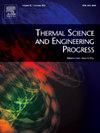医疗建筑采用PCM存储的太阳能和医疗废物综合管理系统的4E分析
IF 5.1
3区 工程技术
Q2 ENERGY & FUELS
引用次数: 0
摘要
本研究的主要目的是提供一个接近零的循环,以确保Bojnord城市诊所所需的冷热负荷和电力。为此,提出了一种新型的多代循环,包括太阳能集热器、医疗废物焚烧炉、吸收式制冷机、ORC循环和用于储能的PCM储罐。光伏电池板全年发电35052千瓦时,其中12636千瓦时被卖给了电网。此外,通过全年燃烧603吨医疗废物,ORC循环产生了37,765千瓦时的电力。7月份的热负荷最高,达到31,628千瓦时。其中,17487千瓦时由辅助加热器提供,其余需求由太阳能满足。该系统每年的能源效率和火用效率分别为6.8%和2.8%。此外,太阳能用于供热和发电的比例分别为55.9%和37.2%。环境分析表明,该循环可将二氧化碳排放量减少至56362 kg/年。最后,经济分析表明,假设利率为3%,NPV值在8年后变为正值。本文章由计算机程序翻译,如有差异,请以英文原文为准。
4E analysis of an integrated solar energy and medical waste management system with PCM storage for healthcare buildings
The main objective of this study is to present a near zero cycle to ensure the required heating and cooling loads and power for the Bojnord city clinic. For this purpose, a novel multi-generation cycle proposed including solar collector, medical waste incinerator, absorption chiller, ORC cycle and a PCM tank for energy storage. The PV panels generated 35,052 kWh of electricity over the year, of which 12,636 kWh was sold to the grid. Additionally, by burning 603 tons medical waste over the year, 37,765 kWh of electricity was produced by the ORC cycle. The highest thermal load was recorded in July, reaching 31,628 kWh. Of this, 17,487 kWh was provided by the auxiliary heater, while the remaining demand was met by solar energy. The energy and exergy efficiencies of the system per year are 6.8 % and 2.8 %, respectively. In addition, the solar fraction for heat and electricity was 55.9 % and 37.2 %, respectively. The environmental analysis concluded that the presented cycle reduces carbon dioxide generation to 56362 kg/year. Finally, the economic analysis showed that the NPV value becomes positive after eight years, assuming a 3 % interest rate.
求助全文
通过发布文献求助,成功后即可免费获取论文全文。
去求助
来源期刊

Thermal Science and Engineering Progress
Chemical Engineering-Fluid Flow and Transfer Processes
CiteScore
7.20
自引率
10.40%
发文量
327
审稿时长
41 days
期刊介绍:
Thermal Science and Engineering Progress (TSEP) publishes original, high-quality research articles that span activities ranging from fundamental scientific research and discussion of the more controversial thermodynamic theories, to developments in thermal engineering that are in many instances examples of the way scientists and engineers are addressing the challenges facing a growing population – smart cities and global warming – maximising thermodynamic efficiencies and minimising all heat losses. It is intended that these will be of current relevance and interest to industry, academia and other practitioners. It is evident that many specialised journals in thermal and, to some extent, in fluid disciplines tend to focus on topics that can be classified as fundamental in nature, or are ‘applied’ and near-market. Thermal Science and Engineering Progress will bridge the gap between these two areas, allowing authors to make an easy choice, should they or a journal editor feel that their papers are ‘out of scope’ when considering other journals. The range of topics covered by Thermal Science and Engineering Progress addresses the rapid rate of development being made in thermal transfer processes as they affect traditional fields, and important growth in the topical research areas of aerospace, thermal biological and medical systems, electronics and nano-technologies, renewable energy systems, food production (including agriculture), and the need to minimise man-made thermal impacts on climate change. Review articles on appropriate topics for TSEP are encouraged, although until TSEP is fully established, these will be limited in number. Before submitting such articles, please contact one of the Editors, or a member of the Editorial Advisory Board with an outline of your proposal and your expertise in the area of your review.
 求助内容:
求助内容: 应助结果提醒方式:
应助结果提醒方式:


